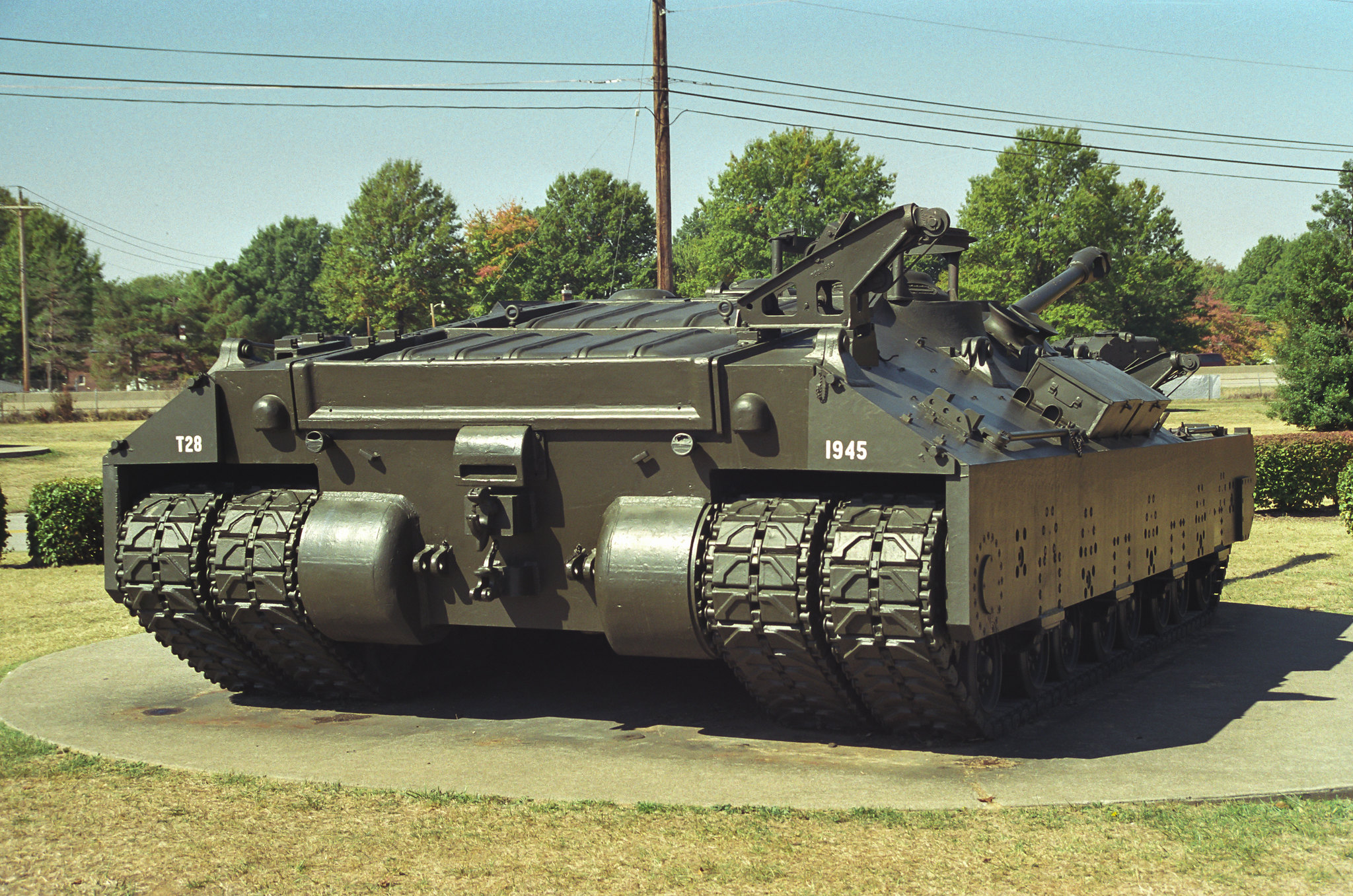
Superheavy Tank T28 – The Mighty Tutel
Today we are finally covering what is in our opinion, one of the coolest and most interesting tanks ever built: the Superheavy Tank T28. Developed during the Second World War as a potential counter to enemy fortifications in Europe, this quad-tracked beast was fitted with so much armor that no anti-tank guns could kill it.
Ironically, the T28 never saw combat, having missed both the end of the war in Europe and Japan before it was ready. But still, weighing nearly 100 tons, having four tracks, a foot of frontal armor and a strong resemblance to a turtle is the perfect recipe for an icon.
Known to many as the Doom Turtle, Zoom Turtle and Tutel for obvious reasons, the T28 has indeed become a legend – even though it never really did much of anything.
And as if the T28’s appearance wasn’t already meme-worthy enough, the US military managed to lose it for almost three decades, before finding it again in a bush. That’s right, they lost a 100-ton tank and found it in a bush three decades later.
However, the T28’s story and existence is often confused, mostly because it went by a few different names back in the 1940s. Today though, we take a deep dive into this awesome machine, covering its background, development, extreme design and how it was lost and found.
A New Heavy Tank
As far back as August 1943, the US Ordnance Department began looking into the possibility of a new heavy breakthrough tank, one that would have armor and firepower surpassing anything the Americans, or anyone else, had yet produced.
Known at the time simply as “A.T. Project”, it was one of many Allied preparations for the German Siegfried Line, also known as the West Wall, which they expected to tackle some time after the inevitable invasion of Europe.
The Siegfried Line was a daunting opponent. It ran for 400 miles down Germany’s western border with France; from the Netherlands all the way down to Switzerland. Covered with bunkers, cannons, turrets, dragon’s teeth and trenches, the Allies spent much time pondering on how to overcome it.
 The Siegfried Line, also known as the Westwall, was almost 400 miles long, and was comprised of widely varying defenses.
The Siegfried Line, also known as the Westwall, was almost 400 miles long, and was comprised of widely varying defenses.
However, they were unaware then that the Siegfried Line was actually a thinly spread, disorganised and unfinished fortification that was not the impassable obstacle they perceived it to be. Much of its reputation was the result of intense German propaganda, the effects of which still continue today.
Still, in September 1943 this was not known, so when the Ordnance Department investigated a new breakthrough tank to tackle the line and other fortifications on the continent, they expected the worst. As such, the new vehicle was required to have the heaviest possible armor and a powerful gun to destroy reinforced structures.
The project was certainly ambitious as the tank was meant to be quite literally impossible to kill, with armor thick enough that it “cannot be penetrated by any guns which the enemy can bring to bear upon it”.
Early Designs
From the beginning of the project the tank was going to be a casemate design; a layout that lacks a turret and instead places the gun inside the hull. This choice allowed massive amounts of armor to be focused at the front and provided the most efficient ballistic profile.
To begin with, the tank was planned to have 10 inches of armor on the front and up to 5 inches on the sides. It would incorporate raw thickness with “very advantageous angles” for the absolute best protection.
Armament was to be the 105 mm T5E1, which fired an 18 kg projectile that could penetrate 180 mm of armor or 1.5 meters of concrete from a range of 460 meters. It was the T5E1’s anti-concrete capabilities that made it particularly useful for a tank designed to tackle bunkers.
 1943 early conceptual artwork for what would become the T28. At this point, it was known simply as the A.T. Project.
1943 early conceptual artwork for what would become the T28. At this point, it was known simply as the A.T. Project.
Also from the beginning was the choice of a petrol-electric drive train, in which a petrol engine generates power for electric motors that drive the tracks. The engine (a Ford GAA-type V8) and electrical transmission was to be taken from the Medium Tank T23, which was in development at the time and laid the early groundwork for the M26 Pershing.
At this time, the vehicle was expected to weigh 80 tons and reach a top speed of 15 mph “under favorable conditions”. It was designated Heavy Tank, T28 (try to keep track of the names).
Development
In December 1943 the Ordnance Department recommended Army Ground Forces to approve the construction of 25, then 24 pilot (prototype) models. Instead Army Ground Forces approved the construction of only three pilot models in March 1944 under a set of conditions, which included:
- Discarding the proposed petrol-electric drive train and instead using a conventional mechanical setup.
- Increasing ammunition stowage
Increasing room for the loader and provide him with an ammunition assist
Increasing the gun’s traverse
The Ordnance Department stated that these changes were possible, but producing only three pilots could significantly delay getting the T28 into battle should be more be needed later on.
Regardless, the final approval for the construction of 5 pilot models came in April 1944.
As is so common with these types of projects, the proportions, scale and capabilities of the tank increased significantly during its development, resulting in a much different design than the original proposal. For the T28, this meant a serious up-armoring, with the frontal armor now planned to be an incredible 12 inches thick.
Of course this had the knock on effect of dramatically increasing weight, which was now approaching the 100-ton mark. Such a heavy vehicle would suffer greatly on soft terrain. To combat this the T28 was equipped with four, yes, four, sets of tracks. This spread the ground pressure out to an acceptable amount, despite the weight.
Suddenly, the tank was too heavy to use even the most sturdy of military bridges used by the US. This was the cause of concern for some, and unsuccessful efforts were made to try and bring the weight back down to the original 80 tons.
In this piece of concept art, we can see the design has matured considerably and is starting to look more like the end design. Note the M26 Pershing-style gun mantlet.
The T28 project was handed over to Pacific Car & Foundry Company in September 1944, who were responsible for finalising the design and producing the five pilot models.
By early 1945 it was thought by some that because the tank lacked a turret, it was more similar to a gun motor carriage than a tank. Therefore in April 1945 the T28 was redesignated as the Carriage, Motor, 105-mm Gun, T95. This name brought it inline with other turretless gun motor carriages.
Work began in May 1945, but due to the war effort drawing in so many resources priority was low, and the war in Europe ended before a hull had even been assembled.
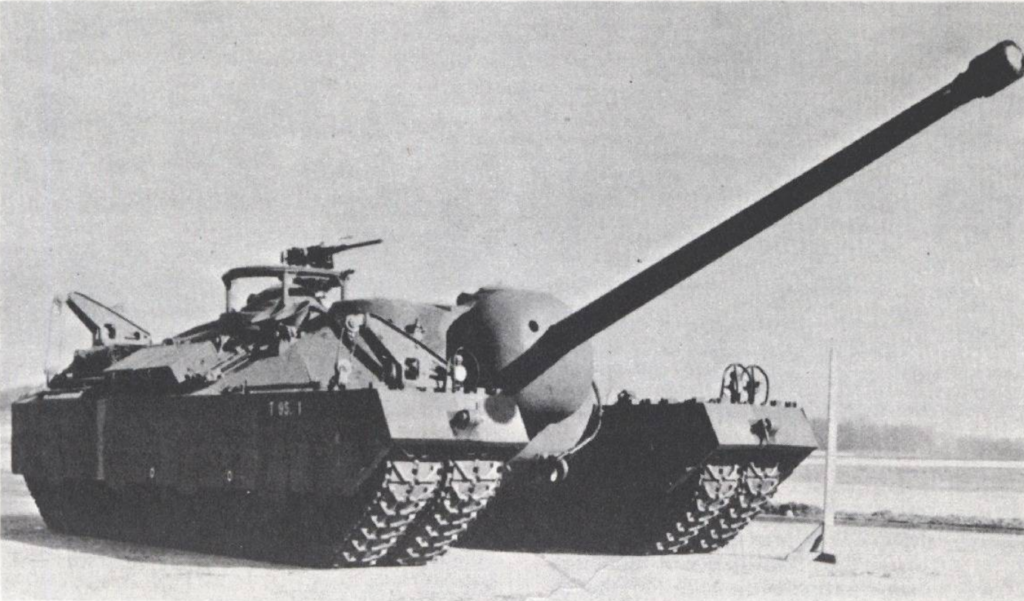 The first T28 wasn’t finished until after the Second World War had ended.
The first T28 wasn’t finished until after the Second World War had ended.
This demolished the T95’s original requirement of tackling the Siegfried Line, but there were plans to use it for the planned invasion of Japan instead. However the T95 would miss this too, as Japan surrendered in August 1945 – the first T95 would be completed the following month.
With the end of the Second World War the order for five prototypes was cancelled, and only the first two T95s were to be built.
T28 Overview
Physically, the T28 is one of the most wild armored vehicles ever produced – in fact, you’d be forgiven for thinking it is a Photoshop job!
The T28 was of a casemate design, with its gun mounted low-down at the front of the hull. In its combat ready state, it measured 11.1 meters (438 in) in length, 2.1 meters (83 in) in height (to the top of the hull), and a massive 4.5 meters (179 in) in width.
The bulk of the main hull was made of cast steel, with rolled homogenous armor plates welded onto the top and rear. The roof was rather bare, aside from two vision cupolas and a gun ring for a .50 caliber machine gun. The T28 contained a crew of four; commander, gunner, driver and loader.
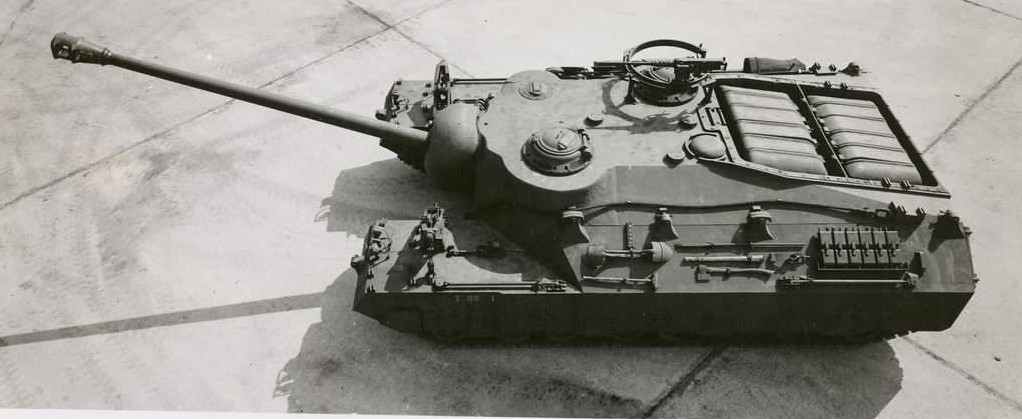 Top view of the T28, showing the large air inlets near the rear and the crew positions.
Top view of the T28, showing the large air inlets near the rear and the crew positions.
At the rear of the vehicle was the engine and transmission, which drove rear-mounted sprockets. Above the engine was two large armored air inlets.
All in the T28 weighed an eye-watering 95 tons.
Quad-Tracks
But, of course, the T28’s most famous feature is its unusual quad-track system, which is almost entirely covered by thick armor. As mentioned, this was to help bring the vehicle’s ground pressure down to stop it sinking into the earth. Each track run had three return rollers and four horizontal volute spring suspension system (HVSS) bogies, for a total of 16 bogies and 64 road wheels.
Each track was 495 mm (19.5 inches) wide, and was made up of 102 individual links for a total of 408 over the four tracks.
 The four tracks are the T28’s most distinct feature. They made the tank exceptionally wide.
The four tracks are the T28’s most distinct feature. They made the tank exceptionally wide.
You may be wondering though, what happens if the one of the tracks are thrown? How do you perform basic maintenance?
Well, that brings us to the T28’s party trick: the outer set of tracks are removable! This gave the crew and mechanics access to both tracks and all suspension bogies. The outer track assemblies also included the thick armor surrounding them, and weighed 12.5 tons each.
In addition to enabling access to the running gear, the removable tracks also dramatically reduced the T28’s width and weight, making transport much easier. Without the outer tracks, the T28’s width was reduced from 4.5 meters (179 in) to a much more reasonable 3.1 meters (124 in), while the weight was reduced by 25 tons.
 The outer tracks removed and connected together. They were towed behind the vehicle.
The outer tracks removed and connected together. They were towed behind the vehicle.
When removed, the tracks could be connected together side-by-side and towed behind the T28 as a single unit.
The process of removing the tracks was a job on its own. Two large crane winches were carried on the vehicle, and could be positioned on each of the tank’s four corners. These were used to help with attaching/detaching of the outer tracks. This could take 2-4 hours on each end of the process (removal and reassembly), depending on the experience of the crew.
Armor and Firepower
As a tank designed specifically to attack fortifications, the T28 carried some serious armor – we’re talking battleship levels here.
The cast front reached a staggering 305 mm (12 in) in thickness, more than the Jagdtiger and even than the 207-ton Maus. Below this was a 133 mm (5.25 in) lower plate, which was angled at 60 degrees. In the center of the front armor was the gun, which was protected by an enormous mantlet 292 mm (11.5 in) thick.
The sides were also immensely thick, made up of multiple layers of armor. The inner-most armor was the sides of the T28’s actual hull, this was 51 mm thick. Next was the layer of armor covering the outer track assemblies, which was an additional 101 mm thick.
 The front of the T28 was 1 foot thick. Even the side armor over the tracks was equal to the Tiger I’s frontal armor.
The front of the T28 was 1 foot thick. Even the side armor over the tracks was equal to the Tiger I’s frontal armor.
Above this, also attached to the outer tracks, was the upper side armor, which was 64 mm thick and angled at 57 degrees. This met flush with the actual hull’s upper side armor, which was of the same thickness and slope.
The roof was 38 mm thick, and the rear 51 mm thick. Interesting, the belly was only protected by 25 mm of steel, offering little mine resistance for a tank designed to attack fixed positions.
The gun, as mentioned, was the 105 mm T5E1. This beast possessed exceptional anti-armor capabilities for the time and would also find use on the T29 heavy tank. The T28 carried up to 62 rounds for this gun, comprised of T30 high explosive and T32 armour piercing capped (APC).
The APC rounds could punch through almost 180 mm of steel and around 1.5 meters of concrete.

Mobility
Powering this monstrous machine was a humble Ford GAF V8 that produced 500 hp and 1,400 Nm (1,050 ft-lbs) of torque. This engine had performed excellently in the 30-ton M4A3 Sherman, but in the 95 ton T28 it was a bit… well, underpowered.
Paired with a 3-speed torquematic transmission, T28 had a maximum speed on road of 8 mph even with massively geared down final drives. Now, as an assault tank meant to slowly crawl up towards enemy bunkers, having a slow speed is not deal breaker.
After all, the original specifications weren’t much better, with designers expecting a top speed of only 15 mph.
The T28 was powered by a version of the Ford GAA, shown here. At 18 litres (1,100 cu in), the GAA is one of the biggest petrol V8s ever made.
If it was ever used the T28 would only have needed to propel itself for short distances when in action. For longer journeys it would have been moved by rail or truck.
However a slow top speed is not the only potential draw back of a severely underpowered engine, as this often translates to low reliability and high maintenance and fuel demands. Again though, with such small numbers and the US’ logistical prowess this too probably wouldn’t have been a deal breaker.
Testing the T28
So, with the world war over and no bunkers needing busting, what do you do with two 95-ton lumps of steel? You put one through intense automotive testing at the Aberdeen Proving Ground (APG) and you send the other off to Yuma in Arizona for engineering tests of floating bridges.
The one at APG racked up a total of 540 miles during its trials, with the majority of that being off-road. Even at the T28’s maximum speed this was still almost 70 hours of driving.
At this point the T28 was actually still known as the T95, after the name change in early 1945. Interestingly though, its designation would be reverted back to a tank in June of 1946, as its lack of a turret was no longer deemed critical to it being defined as a gun motor carriage.
 Here, the T28’s immense weight is being used to test this trailer.
Here, the T28’s immense weight is being used to test this trailer.
Its title was reverted back to T28, but this time, as it was so incredibly heavy, it received a more appropriate designation: Superheavy Tank, T28.
By 1947 the two machines had little more to give regarding testing. The idea of an incredibly slow, almost 100-ton tank that was so specialised for a specific role now had little value to the military. This wasn’t helped by the fact that the T29 heavy tank mounted the same 105 mm gun in a fully traversable turret and at a much lighter weight.
As a result, the T28 project was cancelled in October of 1947.
Lost for 30 Years
One of the most interesting pieces of the T28 story is the fact that one went missing for almost 30 years. Actually, “missing” is probably the wrong word, as that implies someone was looking for it.
When the T28 project was cancelled in 1947, it was reported that the two vehicles were scrapped shortly afterwards. This was the case until 1975, when the magazine “Army Reserve” posted a 1946 photograph of a T28 and invited its readers to identify the weird machine. Hundreds responded with the appropriate answer, but one letter stood out.
It was from an Army Reserve captain based at Fort Belvoir, who stated that there was a T28 sat on a classified night-vision range at Fort Belvoir. Of course, no one believed the captain, as it was common knowledge that both were scrapped decades ago, right?
 The T28, as it was found on the range at Fort Belvoir.
The T28, as it was found on the range at Fort Belvoir.
An expert confirmed the find and contacted the curator of the Patton Museum at Fort Knox. After some back and forth, the staff at Fort Knox eventually confirmed without doubt that this indeed was the real deal: a T28 superheavy tank. In a bush.
Following this the museum arranged the transportation of the T28 to their collection. According to a 1976 Army Reserve article on the discovery, when the T28 was recovered its internals were in remarkably good shape and would have needed minimal work to get it running again.
But while the whereabouts of this tank was unearthed, how, why and when it got to Fort Belvoir in the first place are not known. This 25 year period of the T28’s life remains a mystery today.
Naming Confusion Explained
Like the “Porsche” and “Henschel” turret misunderstandings of the Tiger II, the T28 has a large point of confusion of its own. This confusion is over its names. This is understandable, considering it changed back and forth over the course of its service between T28 and T95. Then, video games such as World of Tanks features two different vehicles under those names, confusing many in the process.
So while we covered the name changes as they happened, we will clarify them here to clear up any confusion.
The project starts life in the late summer of 1943. At this point it is simply referred to as “A.T. Project“, with “A.T. standing for “Assault Tank”.
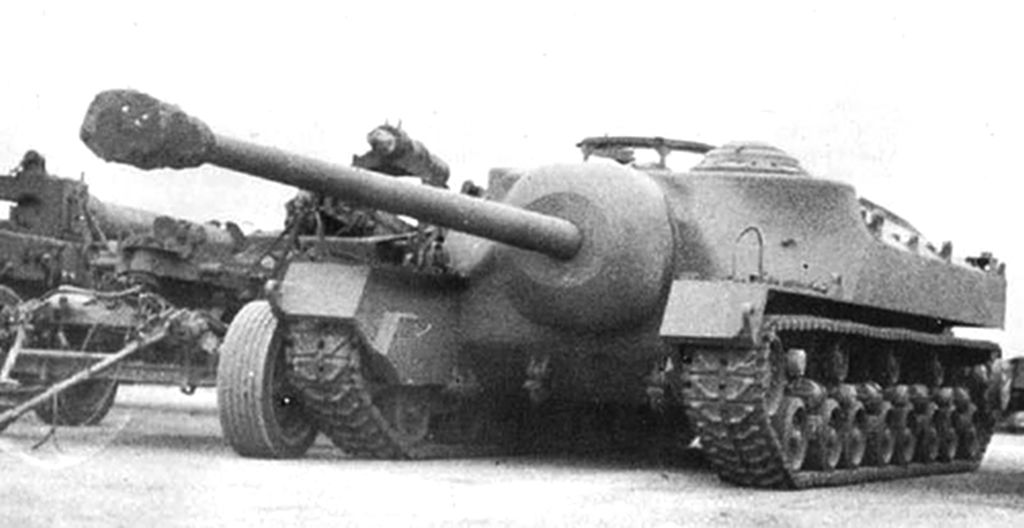 The T28 with its outer tracks removed.
The T28 with its outer tracks removed.
By December 1943 the vehicle is now referred to as the Heavy Tank, T28. The exact wording varies between documents, with some designating it the Heavy Tank T28, while others the Heavy Tank, T-28 and some the Tank, Heavy, T28.
On February 7 1945 there was a request to change the T28’s classification, from a tank to a gun motor carriage. This was because the T28 didn’t have a turret and had limited gun traverse, like many gun motor carriages.
The name change was from Heavy Tank, T28, to Carriage, Motor, 105-mm Gun, T95. This request was approved on April 5 1945. Some documents write this name as 105-mm Gun Motor Carriage, T95.
 The outer tracks, removed and paired together for transport.
The outer tracks, removed and paired together for transport.
It stayed as the T95 for just over a year, when in 1946 its classification was discussed once again. It was now decided that a limited traverse gun and lack of a turret did not strictly make it a gun motor carriage. Gun motor carriages were typically lightly armored and not meant to absorb heavy incoming fire – the T28/T95 was designed with some of the thickest armor ever mounted on a tracked vehicle and designed to directly attack enemy fortifications.
As such, the T28/T95 was more similar in design and purpose to a tank.
Therefore in June 1946 it was renamed for the third and final time to the Superheavy Tank, T28 – a classification made specially for the T28.
So, to recap, the T28’s designations were as follows:
Summer 1943 – A.T. Project
December 1943 – Heavy Tank, T28
April 1945 – Carriage, Motor, 105-mm Gun, T95
June 1946 – Superheavy Tank, T28
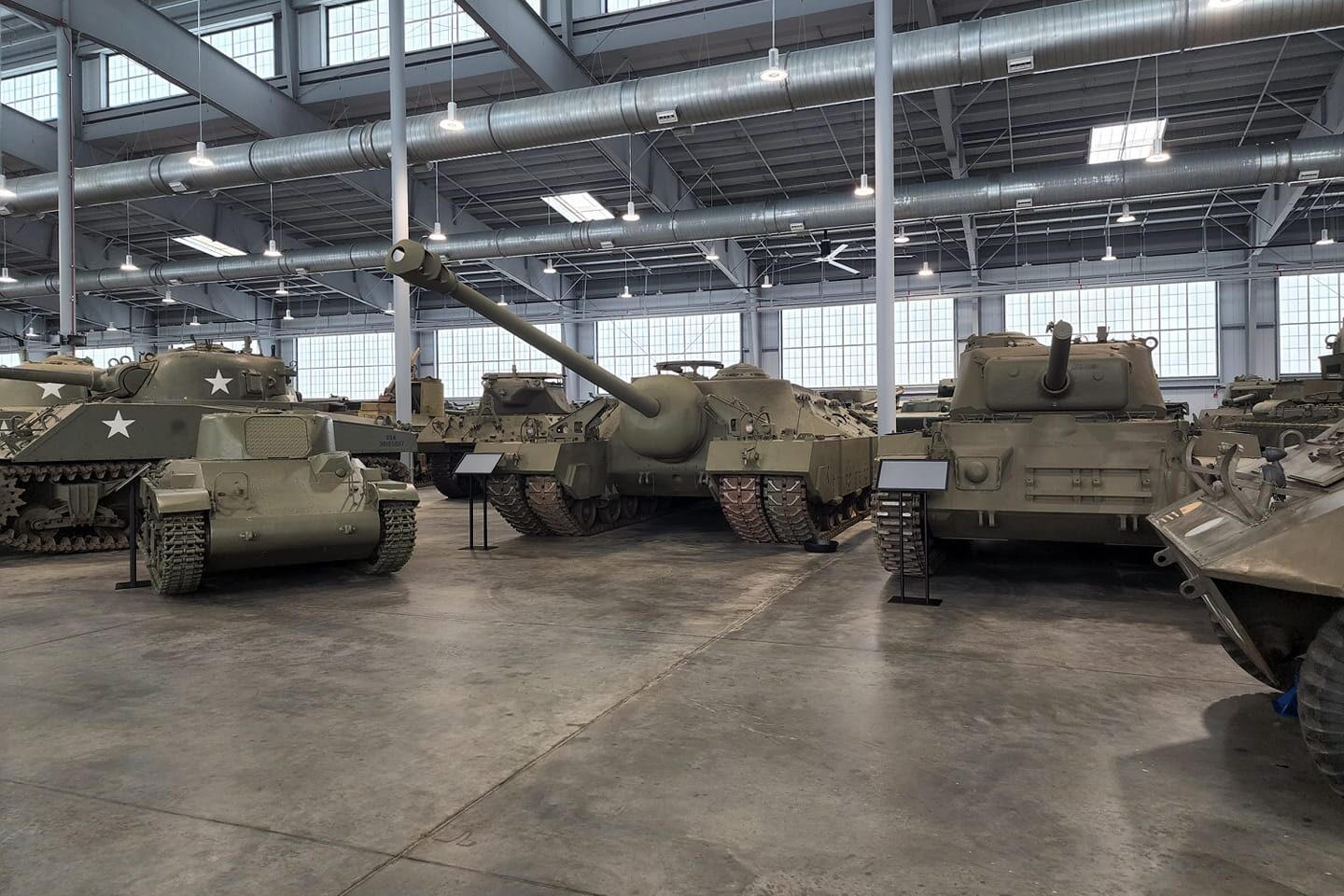 The T28 as it sits today in the U.S. Army Armor & Cavalry Collection at Fort Moore (was Fort Benning). Image courtesy of Michael Hawkins.
The T28 as it sits today in the U.S. Army Armor & Cavalry Collection at Fort Moore (was Fort Benning). Image courtesy of Michael Hawkins.
With that cleared up, we can see that while technically either T28 or T95 are correct names for the tank as they were both used officially, T28 was its final designation before the project was cancelled. Calling it the T95 would also meaning designating it as a gun motor carriage, a classification the vehicle was only paired with for around a year.
T28 was by far the longer lived name, and in our opinion the “correct” one.
That concludes our deep dive into the fascinating history of this remarkable tank. It is one that may not be as well known or iconic as other tanks like the Tiger, but in our opinion is much more interesting.
News
The Hanging Temple: China’s 1,500-Year-Old Cliffside Marvel of Faith and Engineering
The Hanging Temple: China’s 1,500-Year-Old Cliffside Marvel of Faith and Engineering Perched precariously on the cliffs of Mount Heng in Shanxi Province, China, the Hanging Temple, also known as Xuankong Temple, Hengshan Hanging Temple, or Hanging Monastery, is an architectural…
The Willendorf Venus: A 30,000-Year-Old Masterpiece Reveals Astonishing Secrets
The Willendorf Venus: A 30,000-Year-Old Masterpiece Reveals Astonishing Secrets The “Willendorf Venus” stands as one of the most revered archaeological treasures from the Upper Paleolithic era. Discovered in 1908 by scientist Johann Veran near Willendorf, Austria, this small yet profound…
Unveiling the Maya: Hallucinogens and Rituals Beneath the Yucatán Ball Courts
Unveiling the Maya: Hallucinogens and Rituals Beneath the Yucatán Ball Courts New archaeological research has uncovered intriguing insights into the ritual practices of the ancient Maya civilization. The focus of this study is a ceremonial offering found beneath the sediment…
Uncovering the Oldest Agricultural Machine: The Threshing Sledge’s Neolithic Origins
Uncovering the Oldest Agricultural Machine: The Threshing Sledge’s Neolithic Origins The history of agricultural innovation is a fascinating journey that spans thousands of years, and one of the earliest known agricultural machines is the threshing sledge. Recently, a groundbreaking study…
Nara’s Ancient Sword: A 1,600-Year-Old Protector Against Evil Spirits
Nara’s Ancient Sword: A 1,600-Year-Old Protector Against Evil Spirits In a remarkable discovery that has captured the attention of archaeologists and historians alike, a 7.5-foot-long iron sword was unearthed from a 1,600-year-old burial mound in Nara, Japan. This oversized weapon,…
The Inflatable Plane, Dropped Behind the Lines for Downed Pilots
Experimental The Inflatable Plane, Dropped Behind the Lines for Downed Pilots The Inflatoplane from Goodyear was an unconventional aircraft developed by the Goodyear Aircraft Company, a branch of the renowned Goodyear Tire and Rubber Company, also famed for the Goodyear…
End of content
No more pages to load











